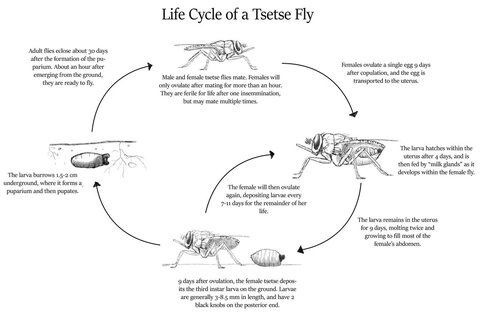What is the life cycle of tsetse?

Female tsetse mate just once. After 7 - 9 days she produces a single egg which develops into a larva within her uterus. About nine days later, the mother produces a larva which burrows into the ground where it pupates. The mother continues to produce a single larva at roughly nine day intervals for her entire life.
The adult fly emerges from the pupa in the ground after about 30 days. Over a period of 12-14 days it matures, mates and, if it is a female, deposits its first larva. Thus 50 days elapse between the emergence of one female fly and the subsequent emergence of the first of its progeny.
This life cycle, with a slow reproductive rate and substantial parental investment in the care of young, is a relatively unusual example of an insect with a so-called 'K-type' life history.
This slow rate of reproduction means that tsetse populations can be eradicated by killing just 2-3% of the female population per day.
For a more detailed description of the life cycle and general biology of tsetse flies, see Stephen Leak's excellent book (Leak, 1999).
References
Leak, S.G.A. (1998) Tsetse biology and ecology: their role in the epidemiology and control of trypanosomosis. CABI Publishing. Oxford and New York. 568pp.